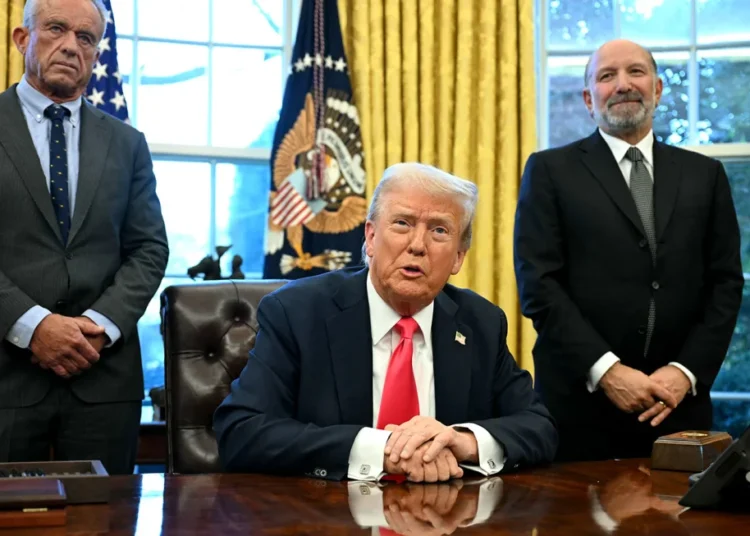In a landmark shift in U.S. immigration policy, the country is preparing to roll out its long-awaited gold card program—a premium residency-by-investment option designed to attract ultra-wealthy foreigners. According to U.S. Commerce Secretary Howard Lutnick, the program will officially launch within the next week, effectively replacing the traditional EB-5 investor visa scheme.
This bold move was announced last week aboard Air Force One by former President Donald Trump himself, who revealed the first prototype of the gold card, emblazoned with his own image and titled “The Trump Card.” The initiative is already making waves in both immigration and investment circles worldwide.
What Is the US Gold Card?
The gold card is a $5 million U.S. residency permit that provides fast-track access to permanent residency and eventual citizenship. Unlike the EB-5 program—which requires a $1.05 million investment (or $800,000 in designated high-unemployment areas) and job creation—this new program dramatically raises the financial bar while simplifying the process.
Investors who purchase the gold card won’t be tied to complex job creation quotas or lengthy waiting periods. Instead, the hefty price tag is expected to streamline application approvals and eliminate many of the bureaucratic hurdles typical of U.S. immigration pathways.
Why the Shift From EB-5 to Gold Card?
The EB-5 program has long been criticized for its backlogs, inconsistent vetting, and vulnerability to fraud. By introducing the gold card, the U.S. hopes to:
•Attract higher-caliber investors with minimal risk of misuse.
•Raise billions in national revenue—Trump estimates one million cards could generate $5 billion.
•Accelerate citizenship pathways for global elites seeking American residency.
•Simplify processing by offering a premium, expedited alternative to the EB-5.
For context, over 4,500 EB-5 visas were issued in 2024. But with the gold card expected to generate significantly more revenue and attract wealthier applicants, it’s poised to reshape the investment migration space in the U.S.
Trump’s Vision: A Billion-Dollar Visa Economy
Trump’s unveiling of the card wasn’t just symbolic—it was strategic. He proclaimed himself the first “buyer” of the card and reiterated that the initiative would bring in the world’s top entrepreneurs, business leaders, and innovators.
“It’s exciting. We may sell a million of them,” Trump told reporters, suggesting that even high-profile foreign investors, including Russian oligarchs, could be eligible.
Whether this becomes a reality remains to be seen, but one thing is clear: the gold card is the centerpiece of an ambitious plan to monetize U.S. immigration in a way that benefits the economy without compromising national interests.
Does the Gold Card Compare to the Green Card?
Here’s how the gold card stacks up:
•Price: $5 million (Gold Card) vs. $1.05M / $800K (EB-5)
•Processing Time: Faster, VIP-style processing for gold card holders
•Job Creation Requirement: None for gold card; mandatory for EB-5
•Residency Benefits: Similar to green card—right to live, work, and eventually apply for citizenship
In short, the gold card offers fewer bureaucratic obstacles, but only to those who can afford its steep price tag.
Global Reactions and Market Implications
Experts in global mobility suggest this move could position the U.S. as a serious contender in the golden visa space—competing with programs in Portugal, Greece, UAE, and the Caribbean.
“By raising the investment bar and simplifying the rules, the U.S. is signaling that it’s open for elite investors,” noted one immigration advisor. “But only the ultra-rich need apply.”
This approach mirrors high-entry programs like Austria’s citizenship by exception and aligns with a growing global trend toward exclusivity in investment migration.
Who Will Apply?
The gold card is expected to appeal to:
•Billionaires and UHNWIs (ultra-high-net-worth individuals)
•Founders of tech companies or multinational businesses
•Celebrities, investors, and politically exposed persons seeking U.S. access
•Families looking for a secure second home and top-tier education
However, critics argue the initiative may further stratify immigration access by making it purely a financial transaction.
The United States is redefining its immigration narrative by trading green for gold. Whether the gold card becomes a game-changer or a flash in the pan, it undeniably introduces a bold, high-stakes element to U.S. residency-by-investment programs.
For investors seeking a fast, prestigious route to American residency—and potentially citizenship—the time to act is now.














